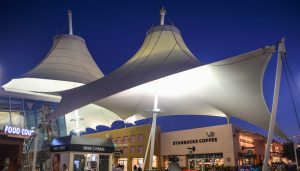Which Type of Fabric is Best for Your Shade Structure?
Blogs
Whether it’s a tent structure for an event, a permanent tensile structure for a public space, or a residential sunshade, the fabric selection you choose for your outdoor shade structure is so important.
Fabric influences not only the aesthetic appeal but also the functionality, durability, and maintenance of the structure as well. Let’s explore some of the most common types of fabrics used in outdoor sunshade structures and learn more about their benefits, drawbacks, and best use cases.

Pros and Cons of PVC-Coated Polyester
Polyvinyl Chloride (PVC) coated polyester is one of the most popular choices for tensile fabric structures. This fabric is known for its durability, flexibility, and ease of maintenance. The PVC coating provides excellent water resistance, ensuring that the fabric remains dry even during heavy rains. This fabric can be easily cleaned with mild detergents, maintaining its appearance over time.
However, PVC-coated polyester is heavier compared to other fabrics, which might require a more robust structural support. Additionally, while water-resistant, this fabric is not breathable so it can trap heat underneath the structure.
Despite these drawbacks, PVC-coated polyester is well-suited for large-scale tent structures, such as those used for events, fairs, and commercial installations, where durability and water resistance are paramount.
Is PTFE-Coated Fiberglass a Good Choice?
Polytetrafluoroethylene (PTFE) coated fiberglass is a high-performance fabric known for its exceptional longevity and strength. This fabric offers superior tensile strength, allowing for large spans and intricate designs without sagging.
PTFE-coated fiberglass can last 25-30 years or more making it a great investment for permanent installations. It also provides excellent resistance to UV degradation, maintaining its structural integrity and appearance over time.
On the downside, PTFE-coated fiberglass is more expensive compared to other fabrics, reflecting its high performance and longevity. Additionally, the material’s rigidity can make installation more complex, requiring skilled labor and specialized equipment. This fabric is ideal for iconic architectural projects, public spaces, and high-end commercial structures where long-term performance and aesthetic appeal are critical.
What are the Pros and Cons of HDPE (High-Density Polyethylene) Shade Cloth?
HDPE shade cloth is a knitted or woven fabric designed to provide shade and reduce heat. This fabric is breathable, allowing air to pass through and providing a cooler environment underneath. It also offers excellent UV protection, blocking up to 95% of harmful rays. Being lightweight, HDPE is easy to install and handle.
However, unlike PVC and PTFE-coated fabrics, HDPE is not water-resistant and allows rain to pass through. Additionally, HDPE fabrics typically have a shorter lifespan, around 10-15 years, depending on exposure and maintenance. HDPE shade cloth is perfect for residential patios, garden covers, playgrounds, and other areas where shade and ventilation are priorities.
Last But Not Least: ETFE (Ethylene Tetrafluoroethylene) Film
ETFE is a highly durable and transparent material often used in innovative architectural applications. It’s not a traditional fabric but offers unique benefits for tensile structures. ETFE can be highly transparent, allowing natural light to pass through while providing UV protection. It is extremely lightweight, reducing the load on the supporting structure. Moreover, the material has non-stick properties, making it self-cleaning and reducing maintenance requirements.
The main drawback of ETFE is its cost, which is relatively high due to its advanced properties and performance. Specialized installation techniques are required, which can increase overall project costs. ETFE is ideal for greenhouses, stadium roofs, and other applications where light transmission and low maintenance are essential.
Which Fabric is Best for Your Project?
Choosing the right fabric for your shade structure is essential to ensure it meets your needs in terms of durability, maintenance, and aesthetic appeal. PVC-coated polyester, PTFE-coated fiberglass, HDPE shade cloth, and ETFE film each offer unique benefits and are suited to different applications.
Whether you’re considering a temporary tent structure for an event, a permanent tensile fabric installation for a public space, or a functional shade solution for your home, we can help you make an informed decision. Ready to get started on your next project? Contact Tensile Structure Systems today and decide which fabric would be best for your next project.
Contact Tensile Structure Systems to Start Your Next Tensile Architecture Structure
We’re here to help you make an informed decision that aligns with your project goals and vision. Our experts are dedicated to helping you craft a masterpiece from beginning to end to turn your vision into a reality.
Contact us today to discuss your project and take the first step toward creating a one-of-a-kind tensile or tension fabric structure that sets you apart.
